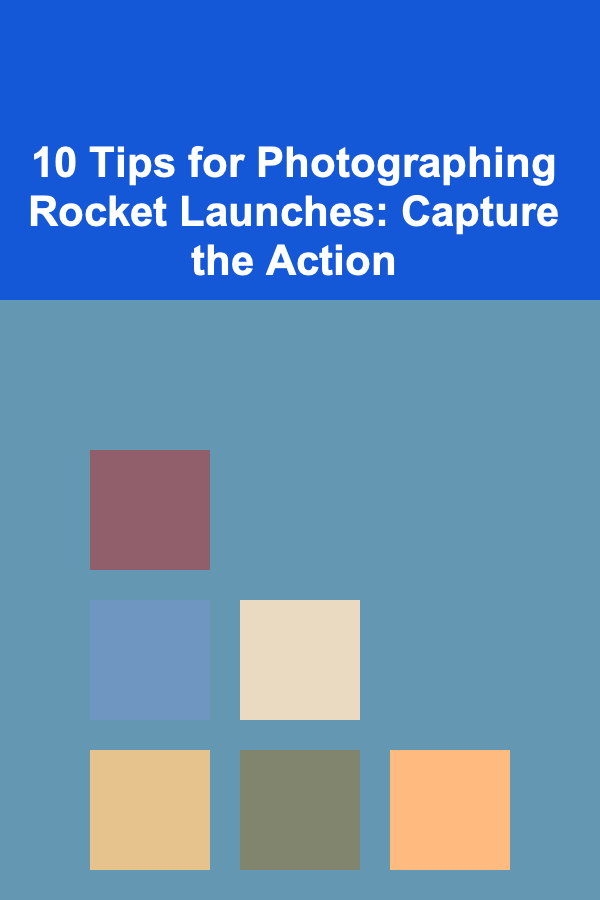
10 Tips for Photographing Rocket Launches: Capture the Action
ebook include PDF & Audio bundle (Micro Guide)
$12.99$6.99
Limited Time Offer! Order within the next:

Rocket launches are a mesmerizing and breathtaking sight, one that offers a unique opportunity for photographers to capture a powerful moment in time. The sheer force, energy, and speed involved in a rocket launch can create stunning images that are filled with drama and awe. However, photographing such a dynamic and fast-moving subject requires careful planning, technical knowledge, and patience. Whether you're capturing a launch for personal memories or for professional work, the following tips will help you improve your chances of getting the perfect shot.
In this article, we'll discuss 10 essential tips for photographing rocket launches to help you capture the action, from preparation to shooting and post-processing.
Know the Launch Schedule and Location
Stay Updated on Launch Times
Rocket launches don't happen on a fixed schedule, and delays are common. However, most space agencies, private companies, and launch sites post detailed launch schedules. These schedules can be found on their official websites or social media channels. They also provide updates regarding any delays or changes, giving you the most accurate information for planning your shoot.
Where to Look:
- NASA's official website and social media.
- Private companies like SpaceX, Blue Origin, and Rocket Lab.
- Local spaceports or observatories that host rocket launches.
- Space-focused apps that track launches globally.
Scout the Location
Before the launch day, familiarize yourself with the launch site and possible viewing points. Some launch sites allow access to public areas, while others might require special permission. If you are shooting from a distance, check for nearby vantage points such as hills, beaches, or observation decks that provide a clear line of sight.
Use the Right Equipment
Camera with Fast Shutter Speed
To capture the fast-moving rocket, you need a camera that allows you to adjust settings for fast shutter speeds. A DSLR or mirrorless camera with manual controls is ideal. Set your shutter speed to at least 1/1000 or faster to freeze the motion and avoid motion blur. Rocket launches involve extreme speed, so even faster speeds like 1/2000 or 1/4000 will help.
Telephoto Lens
A telephoto lens will allow you to zoom in on the rocket from a distance. A focal length between 200mm and 600mm is recommended, depending on your location relative to the launch pad. The closer you are, the shorter the focal length you'll need.
Tripod for Stability
A sturdy tripod is crucial, especially if you plan to use longer exposure times or need to keep your camera steady. The high-speed movement of the rocket will make the camera shake noticeable, so a tripod minimizes this risk. A tripod also helps if you plan to take time-lapse shots before and after the launch.
Filters and ND Filters
Depending on the launch time (such as during the day), the light can be quite harsh. ND (Neutral Density) filters can be useful to reduce the amount of light entering your lens, allowing you to use a wider aperture without overexposing the shot. Consider using a polarizing filter to reduce reflections and enhance the contrast between the rocket's exhaust plume and the sky.
Consider the Weather Conditions
Cloud Coverage
Clouds can create dramatic effects when photographing a rocket launch, especially during takeoff. Clouds can help accentuate the rocket's exhaust plume and create a more striking image. However, heavy cloud cover might obscure your shot, so always check the weather forecast leading up to the launch. Clear skies are ideal, but a few clouds can enhance the composition.
Wind and Visibility
Rocket launches involve large amounts of heat and fuel, so high winds or rain can influence both visibility and the launch itself. Always check the local wind conditions before heading out. High winds might cause delays or even cancellations, but calm winds are generally favorable for photography.
Light Conditions
The best time to capture rocket launches is either during early morning or late evening when the lighting is softer and more flattering. This is especially true for launches scheduled during sunrise or sunset, where the lighting conditions add a magical glow to the smoke trails. However, midday launches can also offer opportunities for interesting shots, with the right settings to control exposure.
Use Continuous Shooting Mode
Capture Every Moment
Rocket launches are incredibly fast, and the critical moments happen in a fraction of a second. To ensure you capture the perfect shot, set your camera to continuous shooting mode (also called burst mode). This mode allows the camera to take several shots in rapid succession, which increases your chances of getting that perfect shot at the exact moment of liftoff or the rocket's peak altitude.
Pre-Focus and Track the Rocket
Focus on a point in the sky where you anticipate the rocket will ascend and lock focus. By pre-focusing, you prevent your camera from struggling with autofocus during the fast-moving moments. Tracking the rocket with your camera while shooting in burst mode also helps you keep the subject in the frame while it moves through the sky.
Consider the Rocket's Exhaust Plume
Capture the Rocket's Afterburner Effect
One of the most striking elements of a rocket launch is the exhaust plume left behind as the rocket ascends. The plume can vary in shape, color, and intensity based on the rocket's fuel and environmental factors. This can add a dynamic element to your photos, especially if you're photographing during sunrise or sunset when the sunlight interacts with the plume.
Try to position yourself so that the sun is behind the rocket, highlighting the smoke and exhaust trail. The plume's color, ranging from bright white to fiery orange, can create stunning contrast against the dark sky.
Adjust Your Camera Settings
Shutter Speed and Aperture
As mentioned earlier, rocket launches are incredibly fast, so a fast shutter speed is crucial to freezing the motion. For aperture, use a small f-stop (such as f/8 or f/11) to get the maximum depth of field and ensure that the entire rocket is in focus.
If you are shooting during the day, you'll need to adjust your exposure settings to avoid overexposure. A quick guide would be to start with a shutter speed of around 1/1000s, aperture at f/8, and ISO set to 100 or 200.
ISO Settings
To minimize noise and keep your images clean, try to use the lowest ISO possible. However, you might need to increase your ISO (to around 400-800) if the lighting is dim, especially during launches at dusk or night.
Focus on Composition
Rule of Thirds
While it's tempting to center the rocket in your frame, following the rule of thirds can make the shot more dynamic. Position the rocket slightly off-center to leave room for the exhaust trail or surrounding elements, such as clouds or the landscape. This helps add balance and keeps the viewer's eye moving through the image.
Include Surrounding Elements
Including environmental elements like the launch pad, ground infrastructure, or surrounding landscapes can help add context and perspective to the image. Shots that show the launch site with people or vehicles in the foreground provide a sense of scale and drama to the rocket's immense size and power.
Consider the Rocket's Trajectory
Capture the Rocket's Journey
Rather than just photographing the rocket at liftoff, think about the entire launch trajectory. If you're positioned well, you can capture the rocket at different points in its flight, including the initial launch, mid-flight, and the moment it disappears into the sky. Tracking the rocket's path with continuous shots will allow you to build a sequence that shows the journey from ground to sky.
Long Exposure Shots
If you want to capture the entire trajectory in one shot, use long exposure. Set your camera to a slow shutter speed (several seconds or more) and track the rocket as it ascends. This will result in a trail of light or smoke that shows the full path the rocket took.
Capture Post-Launch Moments
Check the Exhaust and Afterburner Effects
Sometimes, the best photos aren't taken during liftoff but in the moments that follow. The exhaust plume continues to rise and disperse, often creating striking patterns in the sky. The light can interact with the smoke and clouds in unpredictable ways, so be ready to snap some shots even after the rocket has left the frame.
Capture the Moment of Separation
In some rocket launches, the different stages of the rocket detach during flight. If you're photographing a multi-stage rocket, be ready for moments when stages separate, as these can create dramatic shots with intense lighting and unique formations.
Post-Processing for Impact
Enhance the Lighting
In post-processing, you can adjust contrast, brightness, and sharpness to make your images pop. Emphasize the highlights on the rocket and exhaust plume, while balancing the dark sky or surrounding landscape. Be careful not to overexpose the rocket itself, as details can be lost in bright light.
Remove Unwanted Distractions
Sometimes, rocket launch photos can contain unwanted elements in the background. Use software like Adobe Photoshop or Lightroom to crop out distractions, enhance colors, and add clarity to the rocket's details.
Conclusion
Photographing a rocket launch is both a challenging and rewarding experience. With the right preparation, equipment, and technical knowledge, you can capture the power and beauty of one of humanity's most ambitious endeavors. Keep these tips in mind, and don't forget to enjoy the experience---after all, witnessing a rocket launch is as exciting as the photos you'll take.
Whether you're aiming to freeze the intense launch moment, capture the stunning plume of smoke, or document the entire flight, these tips will help you improve your rocket launch photography and ensure that you leave with stunning, memorable images.
Reading More From Our Other Websites
- [Home Lighting 101] How to Incorporate Outdoor Lighting to Enhance Curb Appeal
- [Screen Printing Tip 101] From Canvas to Timber: A Beginner's Guide to Screen Printing on Wood
- [Organization Tip 101] How to Incorporate Multi-Functional Furniture in Your Bedroom
- [Home Cleaning 101] How to Clean Your Home for the Winter Season
- [Needle Felting Tip 101] DIY Needle Felting Toolkit: How to Assemble the Perfect Portable Set
- [Ziplining Tip 101] Avoid Common Mistakes: Expert Advice for Flawless Zipline Experiences
- [Home Security 101] How to Prevent Identity Theft Using Smart Home Devices
- [Home Rental Property 101] How to Maximize Rental Income from Your Home Property
- [Home Holiday Decoration 101] How to Incorporate Global Holiday Traditions into Your Home Decor
- [Trail Running Tip 101] Endurance Meets Elevation: A 2-Hour Trail Run Circuit for Ultrarunners

How to Build a Travel-Based Career: Earning Money While Exploring the World
Read More
How to Create Engaging Content That Attracts Followers
Read More
How to Redecorate Your Home Using Only What You Already Own
Read More
How to Stage Your Home to Sell Faster and for More Money
Read More
How to Track Alcohol and Tobacco Expenses Discreetly
Read More
How to Build a Yoga Routine Checklist for Beginners
Read MoreOther Products

How to Build a Travel-Based Career: Earning Money While Exploring the World
Read More
How to Create Engaging Content That Attracts Followers
Read More
How to Redecorate Your Home Using Only What You Already Own
Read More
How to Stage Your Home to Sell Faster and for More Money
Read More
How to Track Alcohol and Tobacco Expenses Discreetly
Read More